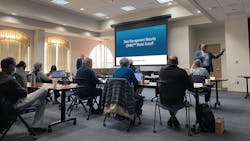Organizational culture and the benefits of asset management
With the coming wave of retirements facing water utilities and recruiting challenges across the industry, addressing cultural challenges is no longer an option, but a necessity.
Over the past few years, culture has become a buzzword for improving performance and revenue. In the wake of the Covid-19 pandemic, studies have shown that organizations with strong, distinctive cultures have greater resilience, retention, and business advantages.[1] General managers, CEOs, executive directors and other leaders want to improve their organizations’ performance and culture, but it can seem like a mysterious, time-consuming and often fruitless endeavor.
Cultural Challenges Facing the Industry
Culture is hard to pin down, but it can be correlated with some key issues that drive organizational dysfunction:
- Recruitment issues – Culture is more important to employees and job candidates than ever. They expect detailed information about organizational culture before they are hired. Early retirements coupled with a general talent shortage for many technical positions has led to a dearth of qualified employees. Recruitment and retention of skilled workers has long been a challenge, but competition for highly skilled employees is fierce.
- Turnover – Surveys show that the main reason for leaving a job is a toxic workplace culture.[2] Culture is more predictive than compensation and work-life balance in determining whether current staff will continue to stay in their present roles.
- Productivity and engagement – Disengaged employees can bring down productivity and performance. Vibrant cultures are correlated with strong engagement and improved performance.
- Differentiation – In a crowded marketplace competing for employees and eyeballs, a distinct organizational culture can provide differentiation and competitive advantage.
- Consistency and standardization – Dysfunctional cultures lack coherence and risk idiosyncratic approaches to project delivery or fulfillment of job tasks.
Why asset management matters
These cultural challenges are widespread but especially tough on the water sector. Around a third of the workforce is eligible to retire in the next five to 10 years while fewer young people are entering the profession.[3] At the same time, aging infrastructure is creating critical challenges.
A solution to both these challenges can be found in asset management. Implementing an asset management program and employing asset management principles can improve workforce satisfaction, productivity and operational efficiency while extending the life of assets.
By analyzing data from various sources, water sector utilities can determine which assets are most critical to the overall system and allocate resources and labor accordingly. Less downtime and more efficient use of staff results in fewer costly service disruptions.
Asset management encourages water sector utilities to improve their workforce performance through proactive training and education. By identifying the specific skills and knowledge needed to manage assets effectively, water sector utilities can upskill their staff for more effective performance, while employees increase their confidence and competence. The result is improved workforce culture.
Seven ways asset management supports culture
Below are seven ways asset management best practices can help water utilities understand and improve their culture.
- Strengthen the culture and empower the people with data
Establishing an asset management program shifts the culture toward data. Decisions will become data-driven rather than reactive. Use this shift to set up and track key performance indicators linked to organizational goals to enable accountability and transparency. Make culture and its performance indicators a regular part of leadership meetings and all-staff events. Report on the findings, measure improvements, and share that information with employees so they know that leadership considers culture an asset that must be supported. - Train and improve existing staff
Asset management programs clarify staffing needs and the skills needed to keep a utility functioning smoothly. Candidates for skilled positions can be hard to find, but management can train and upskill existing staff to fill essential roles. Developing staff keeps them engaged and prepares the industry for the future. Do not worry that upskilling employees will make them more desirable to other employers: by investing in staff and making the skills needed for the future of the water sector a standard part of training and on-boarding, employers increase the quality of work and improve the chances of retention. - Improve staff alignment
Asset management brings together staff from diverse wor groups to jointly plan programs for selecting, installing, operating, maintaining and replacing assets. Workshops to develop strategic asset management plans can result in better communication and alignment throughout the utility. When these workshops end, utilities should maintain improved alignment around a common goal by including performance measures and successes in regular joint staff meetings. With asset management, staff have line of sight to their role in meeting the utility’s mission. Encourage collaborative projects and shared successes to maintain that alignment and sense of common purpose. - Plan for succession
With the retirement of long-term staff comes the inevitable loss of institutional knowledge. Retirements cost utilities the people who instinctively know how the system works and what to do when something fails. Asset management programs create a record of this institutional knowledge that can support less-experienced staff during transitions. Cross-train staff wherever possible to fail-safe institutional knowledge and encourage staff to find learning activities that would benefit them in the long run. - Adjust salaries to attract and retain skilled staff
As the skills needed by the industry shift, compensation needs are also evolving. Improvements in technology mean that we can do more with less staff. Adjusting your compensation to allow staff to improve their pay along with their value can encourage them to take advantage of training opportunities and acquire new knowledge. The cost of paying increased salaries for staff is usually less than the cost to replace qualified and experienced staff that have left the organization. - Employ innovative technologies to reduce labor time
Asset management encourages the use of technologies and tools to reduce labor time on routine tasks, such as upgrading to smart meters or using condition-based monitoring sensors. As part of succession planning, utilities can plan for a leaner workforce that uses technology to streamline routine work. While modern technology has capital and startup costs, in the long-term it can free up budget to increase wages and attract more skilled job candidates. - Outsource specialized work when appropriate
Using specialized contractors is an option for utilities having trouble attracting staff for facilities in less populated areas. For utilities that cannot find job candidates with the right qualifications or certifications, or those who do not need a full-time employee, hiring a contractor will help identify and outsource tasks requiring specialized skills, such as planning, data management, or engineering tasks. In some cases, private sector employees with specialized skills can work alongside regular utility staff.
Consistency over time
Asset management provides toolsets for utilities to improve culture while tackling asset and infrastructure challenges. Culture does not change overnight but, through asset management principles, a utility can encourage behaviors that align with its mission.
By tracking performance over time, a utility can start to shape the culture to meet its goals. Along the way, these processes will improve recruitment and retention, increase employee engagement and productivity, and align the utility’s mission with its culture. WW
Citations



